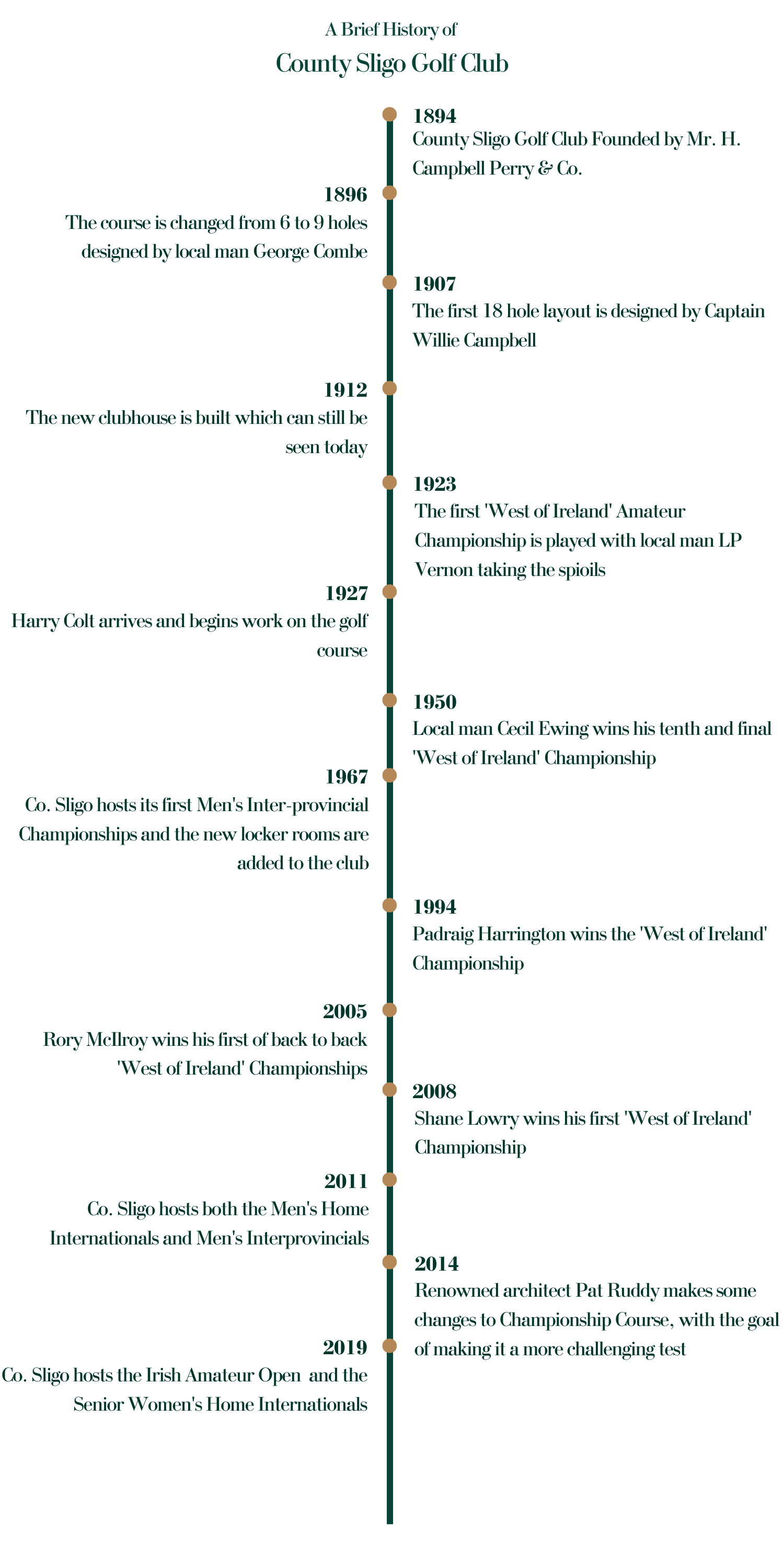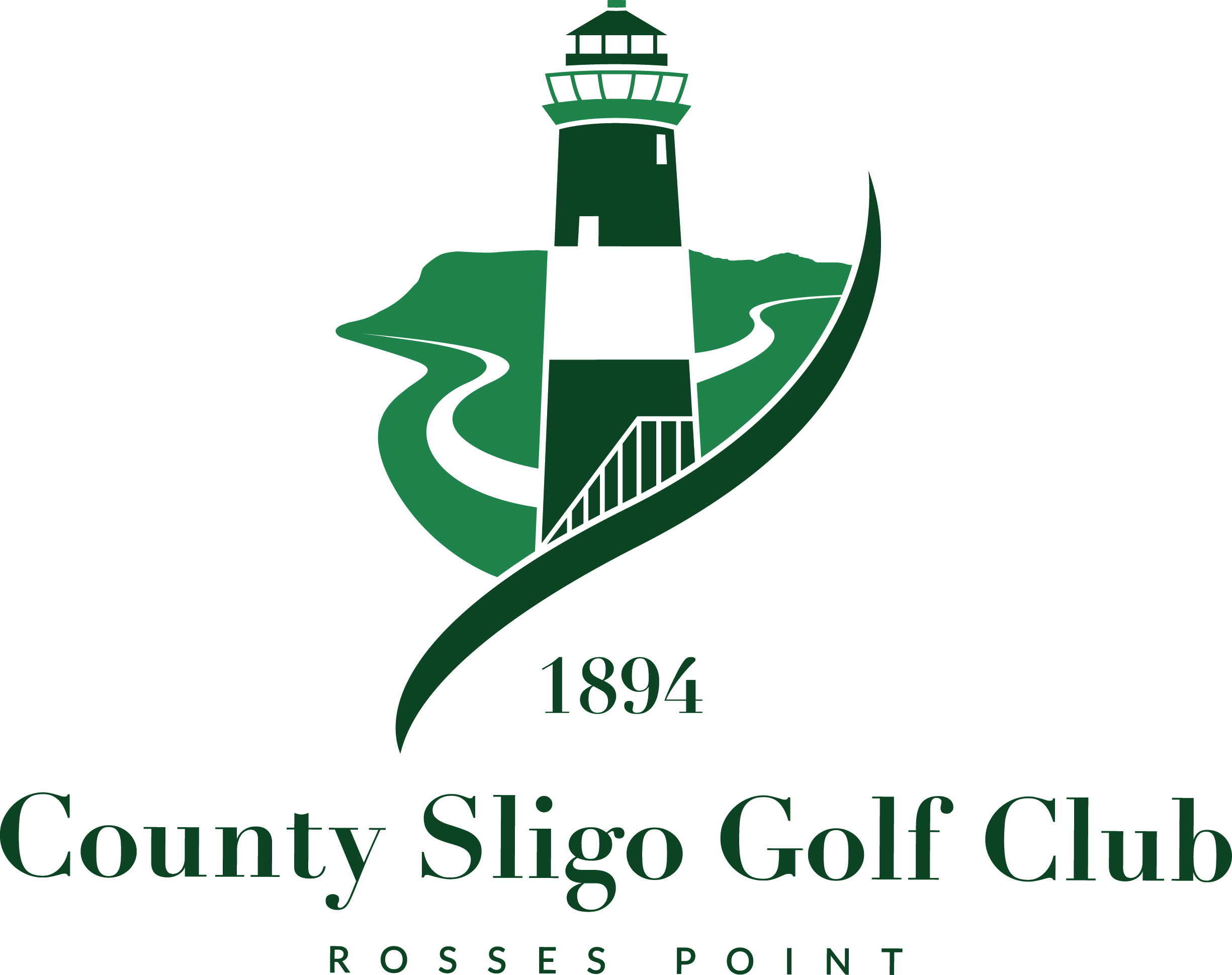
The County Sligo Golf Club, or Rosses Point as it is more popularly known, is situated some 8km from Sligo town on a headland under the shadow of Ireland’s table mountain Benbulben on one side, and Knocknarea with Queen Maeve’s grave on top on the other side. Designed by Harry Colt it is one of Ireland’s great championship links.
Home of the West of Ireland Amateur Open Championship since 1923 the club has also been the venue for the Irish Open Amateur Championship, the Irish Close Championship and has hosted the R&A Home Internationals and the Irish InterProvincial Championships and the Irish PGA Championships.
The course enjoys a magnificent location with breathtaking views of the mountains, sea and rolling countryside and is a setting for golf that one will never forget. The view from the third tee is a superb panorama of the area immortalised in the poetry of W.B.Yeats. One can see five counties from here on a clear day.
The game of golf came to Sligo in the days of the old Sligo Militia who had a camp in the area and played a number of holes around the camp. In 1894 Colonel James Campbell one of the officers, and a Sligo business man, conceived the idea of forming a club and secured the lease of the area known as the “Greenlands” from the Middleton family for that purpose.
The inaugural meeting for the formation of the club was held in Sligo Courthouse on the 18th October 1894 with Col. Campbell in the chair. He formed a committee with Arthur Jackson, another prominent Sligo business man, and his nephew Harper Campbell Perry as the first secretary to run the club. The club had 96 male members on its formation and Col. Campbell was elected as the first Captain in 1895. He served as Captain until 1903 with Arthur Jackson then taking over.
The minutes of that meeting tell us that: The name of the club shall be “The County Sligo Golf Club”. The Council and the Hon. Secretary and Treasurer shall remain in office until resignation or the cease to reside in Co. Sligo or to be a member of the club or until a general meeting by three-fourths of the members present, shall vote to remove them. The entrance fee was set at £1/1s and was to commence on November 1st of that year. A week later it was agreed to admit Ladies for a subscription fee of 10s/6d.
Col. Campbell then engaged the services of George Combe, a notable golfer and subsequently the first secretary of the Golfing Union of Ireland to lay out nine holes on the land. Combe also had the distinction of devising the world’s first handicapping system for the game. He was also closely associated with Royal County Down Golf Club. The local hotel owned by Mr. Tom Ewing, just across the road from the club was used as the first clubhouse. In 1896 George Combe presented the “Combe Cup” to the club to mark his association with the club and the opening of the nine holes. The Combe Cup is still played for in the August Open Week.
In 1907 it was decided to extend the course to eighteen holes, more land was leased and the holes were laid out by Captain Willie Campbell a step brother of Colonel Campbell. Willie Campbell was an accomplished golfer and sports man he played for Ireland in one of the first internationals in 1906. The new holes which took a clockwise direction out along the beach were integrated with the original nine holes.
In 1912 a new clubhouse was designed by George O’Connor and built by James Kiernan. The Tudor style pavilion is unique and attractive and was extended and modified over the years. Today it is preserved under the direction of the National Inventory of Architectural Heritage.
The first “West of Ireland Open Amateur Championship” was held in August 1923 and was won by a local man Larry Vernon who was home on holidays from South Africa. Vernon beat B.M.Cook, a Scotsman, in the final. There were 42 entries with 16 players qualifying for match play after 36 holes stroke play.
In 1927 due to the advances in equipment, the carry of the ball and the general evolution of the game it was decided that an up-grade of the course was needed. The club engaged the services of Mr. Harry Shapland Colt of the famed golf architects Colt & Allison. Colt was acknowledged as one of the foremost golf architects of his time with a long legacy of course designs in the USA, Europe and throughout the British Isles which includes a number of prominent Irish courses. His work at County Sligo has been identified as one of his four greatest achievements alongside Wentworth, Sunningdale (new course) and Moor Park’s West Course.
Colt arrived in Rosses Point in June 1927 and his proposed plans were adopted by the club. In contrast to the earlier Coombe Campbell course Colt opted for an anti-clockwise pattern which he had admired at the Old Course St Andrews, Royal Troon, Royal Lytham and St Annes and he implemented this configuration at Royal Dublin and Royal Portrush. The design drawings are displayed in the Members bar.
The work was carried out in 1928 and 1929 and this layout set among the sand dunes and cliffs overlooking the Rosses Point beaches remains in play today. Features such as elevated tees, meandering burns, subtle undulations and the constantly changing sea breeze have provided a most enjoyable challenge over the decades.
Many distinguished visitors and writers have praised Colt’s work at Rosses Point such as Robert Trent Jones, Henry Cotton, Tom Watson, Peter Allis and Rory McIlroy to name a few. Comments describing “the 10th and 11th holes as great Colt holes” and Cottons rating of the 4th hole as “among the finest par 3’s in the world”, Watson’s “one of the best finishing stretches in golf” all confirm the wide appeal of the design not to mention the scenic setting. To the end of the twentieth century there were some modifications with improved tees, greens and some additional bunkers.
In 2013 renowned golf architect and Sligo native Pat Ruddy was invited by the members to “Revitalise a Classic”. Ruddy pointed out that the championship course hadn’t been given a good work-over for several decades and during that time, the ball had changed, clubs had changed and above all, players had changed. A soft-engineering approach was chosen by Ruddy so as to sit comfortably beside the Colt legacy and his proposed solutions could not be based on length alone.
Over the following years under the Ruddy programme every hole was improved with the exception of the four par-threes, which he deemed to be superb as they are. Adding new sections to existing greens Ruddy created a number of new and more challenging championship pin positions without tampering with the genius of Colt. The 3rd green was the only one moved to a new location while the 15th was redesigned to enhance the links presentation make the green more demanding for incoming nine-iron or wedge approaches.
While much emphasis was placed on revitalising the championship links, great care was taken to maintain what Peter Allis described as “a tremendous test for the highest quality player and great fun for the modest competitor”.
The County Sligo golf club has had significant success in Irish golf’s inter-club championships. It was the first club in Connacht to bring the Irish Senior Cup west of the Shannon, and indeed has repeated this success a number of times since. The club has also won the Barton Shield as well as other National pennants at senior and underage levels.
Among the notable members of the club was Cecil Ewing, born in Rosses Point, a son of Tom Ewing the local hotel proprietor. He first played in the West of Ireland at age 18 and won the Championship on no less than ten occasions. He competed in all of the major Irish Championships and was successful in most of them. He represented Ireland many times and also Great Britain and Ireland in the Walker Cup on a number of occasions. In 1938 he reached the final of the British Amateur Championship, losing to the American Charlie Yates. The clubs principal meeting room is aptly named the Ewing room and houses much memorabilia from Ewings playing days.
Another local golfer was a lady Amy Ormsby who in May 1909 won the Irish Ladies Close Championship in Lahinch. On emigrating to South Africa with her husband Larry Vernon (winner of the first “West”) she won the Ladies South African Championship on no less than 4 occasions.
In more recent times many members of the club have had success in national championships at senior and underage level and similarly many have represented Ireland.
Many other golfers of note have graced the Rosses Point fairways such as Christy O’Connor Snr., Christy O’Connor Jnr., Harry Bradshaw, Walter Hagen, Joe Kirkwood, Norman Von Nida, Henry Cotton, Tom Watson, Byron Nelson, Nick Faldo, Peter Allis, Bernhard Langer, Padraig Harrington, Paul McGinley, Rory McIlroy, Shane Lowry and most of the Irish professionals. Great amateurs like Joe Carr, John Burke, Gerald Micklem, Jimmy Bruen, Joe Brown and locals like the Mahon brothers among many other top amateur players were frequent visitors to Rosses Point.
Rory McIlroy won the “West” at the age of fifteen in 2005 the youngest player ever to do so, he won again the following year before going on to greater things in the professional game. Padraig Harrington another multi major winner in the professional game won the “West” in 1994. Shane Lowry also had success in the championship winning in 2008. After a long wait, Rosses Point local man, Barry Anderson won the “West” in 2017. Paul McGinley won the Irish Close championship which was staged at Rosses Point in 1989.
The course at County Sligo has, over the decades since the 1930’s, always been highly rated as one of the great Irish courses. Major Champion and Ryder Cup player Bernard Langer said “Rosses Point was the first links course that I ever saw as a young professional starting out the Tour circuit, I went to play one round and stayed for two weeks”.
Peter Allis was also very impressed on his first visit to the club and stated afterwards; “Rosses Point is a gentle sleeping giant and a course that one should go and look at and I think they will come away marveling at its beauty. The great test of a golf course is that it can be a tremendous test for the highest quality player and great fun for the modest competitor and that is where you have got it made. I had never visited the course before but had heard a lot about other Irish courses, but Rosses Point stands at the very top of the list of Irish courses and is one that more people should discover “.
